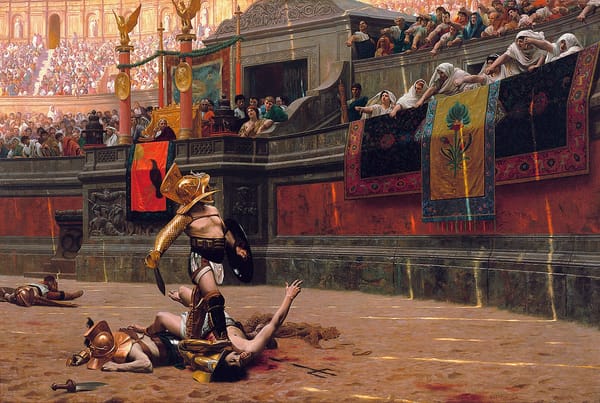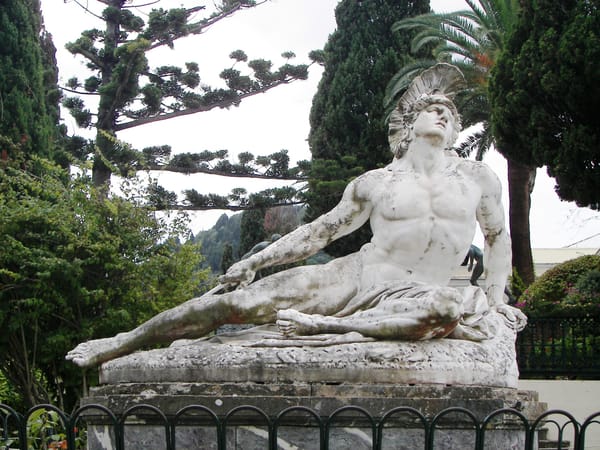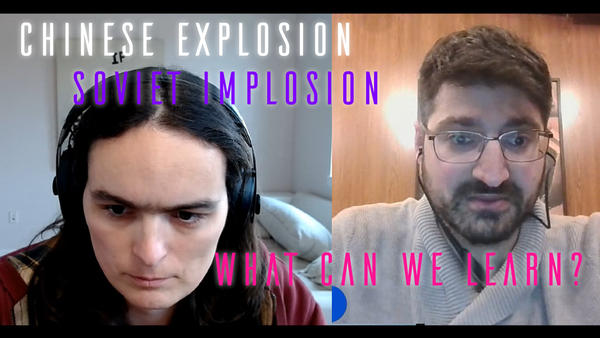Liberalism for the 21st Century
We must stop shadowboxing old enemies and focus on reactionaries holding the daggers to our throats today.

Liberals need enemies. The problem with liberals today is we don't know who our real enemies are. We get confused, fighting old fights and chasing phantasms. But our enemies are clear. They are MAGA, white supremacists, antifeminists, and oligarchs.
When we ask what it means to be a liberal in the 21st century, we should ask what it has meant to be a liberal in the past. Liberalism has never been any one thing, but has taken different forms in different times and places, based on what the most pressing threats to freedom are in each context.
The early stirrings of liberalism in response to the wars of religion focused on confessional freedom and religious toleration. An individual isn’t free if he can be pressed into service to kill and die for some religion, whether he believes in that faith or not. People can’t be free if they are compelled by the sovereign to profess beliefs and adhere to doctrines they don’t genuinely hold, and prevented from practicing their true faith.
In other contexts, freedom of religion—securing the rights and privileges of religious institutions to practice their faiths unmolested—was less relevant than freedom from an all-powerful priestly class. In Latin America in the nineteenth century, liberalism tended to be anticlerical—the Catholic Church was often the dominant landowner, and the clergy enjoyed power and privileges unmatched by any other institution. The Church in the ancien régime in France also enjoyed outsized privileges, though they competed with the landowning nobility.
Religious institutions can thus help and hinder political freedom. An organized church can be a crucial intermediate institution for securing freedom in some contexts while in others it is a threat to freedom and equality.
Or consider nationalism. In the twenty-first century, we often think of nationalism as jingoism, a nasty political force that leads to war and the suppression of ethnic minorities. Yet in the age of revolutions liberalism was often associated with nationalism. The difference isn’t anything intrinsic to nationalism itself, but the social and political context. When multinational empires are ascendant and metropoles dominate a colonial periphery, nationalism can be a way of building oppositional power. Nationalism can thus be a vector for freedom.
Laissez faire liberals saw the state as the gravest threat to liberty, both in its absolutist pretensions and its meddlesomeness (we denizens of the twenty-first century tend to forget about the intrusiveness of things like sumptuary laws, though we're being reminded of the opportunities for corruption that high tariffs bring). But black American liberals in the nineteenth century saw a potential ally in the state. It was the only institution powerful enough to counter the hyperlocal totalitarianism of chattel slavery and the racial terror that followed its abolition.
As a final example, consider how so much of liberalism oriented itself against communism in the twentieth century. It’s hard not to conclude that Cold War liberalism went overboard. Certainly McCarthyism was a dark chapter in American history, and our habit of military interventions and sponsored coups in order to halt the spread of communism did lasting damage.
Yet it’s also hard not to sympathize with how liberals perceived a genuine, even existential, threat. The USSR was nuclear armed and had manifest imperialist ambitions. The communist worldview held a significant fraction of the Western intelligentsia in thrall. Espionage and sabotage within liberal nations was common. It doesn’t matter for the sense of threat that such behaviors were reciprocated—the threat was real. It made sense that liberals constructed their theories with the enemy of communism in mind.
The context of liberalism
If liberalism always has some threat or enemy in mind, even if it’s implicit, then to understand how to build a liberalism for the twenty-first century, we should ask ourselves: what are the most acute threats to human freedom? What institutions and values most need defending? What institutions have outlived their usefulness? What erstwhile liberal commitments are now distractions from more pressing concerns?
It'll come as no surprise when I say the greatest threat to freedom today is ascendant far right politics. Far right parties around the world are no longer really conservative, but stridently antidemocratic, ethnonationalist (white supremacist in the American case), misogynistic, and oligarchic.
Democratic
MAGA has every interest in maintaining Trump in power for as long as he draws breath, and to replace him with a chosen successor when the time comes without the bother of a competitive election. This was clear even before the January 6th insurrection, but it becomes clearer every day of Trump’s second administration. MAGA has found inspiration and camaraderie in the other dictators and far right parties of the world: Putin, Orbán, Bolsonaro, Erdoğan, the AFD, Front National, and the list goes on and on. This is a threat to representative government and the freedom of individuals to have a say in the laws that govern their lives—indeed it’s a threat to replace the law as such with rule by the corrupt personal interests and caprices of a dictator.
Liberalism hasn’t always had a particularly friendly relationship with democracy, though it has always stood for representative government in some form. Yet the struggles for freedom—against colonialist subjugation, against apartheid, and against racist oppression and segregation—over the last two centuries has revealed that democratic voice and universal adult suffrage within stable democratic institutions is crucial for securing durable freedom and prosperity for all. We can no longer afford the liberal flirtations with so-called “epistocratic” mechanisms or benevolent “liberal” dictatorship à la Pinochet or Singapore.
Liberalism in the twenty-first century must take a hard line on democratic rights for all, proportional representation for historically oppressed groups (securing fair representation of groups is how the individual’s rights are protected), free and fair elections, and relentless animus against political entities and institutions that threaten these. In the American context, this includes the MAGA-captured Supreme Court, the Senate and Electoral College, and the Republican Party itself, which has committed itself to overturning democracy in favor of autocratic rule.
Antiracist
MAGA is attempting to resegregate public life along racial lines. In the MAGA vision, America is a nation of, by, and for the white race. To the extent there is a role for nonwhites in America at all, it is for menial service and labor. This is especially true for blacks, as other people of color are, according to Trump, poisoning the blood of the nation. This is the upshot of the obsession with mass deportation, the closed border, and the masked secret police intent on terrorizing the populace and kidnapping innocent civilians off the streets. MAGA is enacting its values, which can be handily summarized with a mere fourteen words: “We must secure the existence of our people and a future for white children.”
This is also the purpose of the heavy-handed campaigns by the Trump administration and its state allies against DEI (diversity, equity, and inclusion) and its orchestrated moral panic about critical race theory (CRT). The censorship and intimidation of state and local governments, universities, and private companies by the Trump administration to eliminate DEI programs, including targeted harassment of black university administrators, is of a scale not seen since at least McCarthy’s Red Scare. There can be no doubt that the Trump administration's metric for whether “DEI” has been sufficiently extinguished is that the number of blacks and other minorities in high status roles be low and getting lower. To Trump and MAGA, the presence of black people in positions of public esteem and authority is in itself unAmerican.
Liberalism has often had a rather fairweather friendship with minorities, making inclusive noises and taking credit for the achievement of a more diverse and pluralistic society when the political winds are favorable, and sacrificing minority interests on the altar of expediency when the political costs seem high. It’s not for nothing that Martin Luther King Jr reserved his sharpest rebukes for the “white moderate,” or what we would today call the reactionary centrist, who is quick to charge minorities and their allies with “illiberal” excesses, and to blame them for social turbulence and political defeats.
Even in the age of Trump, where the white supremacist ideology is often explicit in words and pointed in policy, reactionary centrists point to “illiberalism on both sides” and the “regressive left.” To state the matter plainly, there is no significant illiberal threat from the left in America.
The actual assault on free speech is entirely from the right, with real individuals hounded out of their jobs or abducted off the streets for expressing ideas unpopular with the regime. Political correctness and cancel culture were always moral panics concocted by the right. Centrist liberals handwringing over illiberalism on the left, willing to believe every fantastical lie about campus leftists and racialized minorities (black, Arab, Latino) have always been gullible stooges of the right at best, willing accomplices at worst.
But there have also always been liberals committed to securing freedom for all persons. Black liberals like James Baldwin, Frederick Douglass, and Ida B. Wells have been stellar examples in this regard. These figures never subscribed to the thin gruel of colorblind, don’t-say-anything-to-upset-the-whites liberalism so popular with reactionary centrists. On the contrary, these and other black liberals have always sought freedom for all by seeking first and foremost freedom for those hardest oppressed. In the twenty-first century, we should follow the examples of racialized liberals, not out of a sense of fairness or inclusion—not for the sake of DEI—but because liberalism isn’t fit for purpose without those examples. Liberalism fails to liberate when it ignores, minimizes, or condemns as illiberal excess the social movements of the marginalized.
Feminist
One common thread among the rightwing reactionary movements across the globe is the desire to return to what is imagined to be traditional gender norms, with men acting, earning, and being out in the world while commanding the household. The woman’s place, of course, is in the home, keeping the hearth and rearing as many children as can be borne. I'm talking about cis women, of course. There is no place at all for trans people or people with non-hetero sexualities.
That’s patriarchy, familiar enough. But there is no patriarchy without misogyny to enforce its normative vision. In the MAGA worldview, institutions must be structured to coerce women into these roles. The possibility of lesbianism must be barred. The existence of trans people must be erased. And those who insist on these alternatives to cis-heteronormativity will suffer the consequences—conversion therapy, rape, denial of healthcare, social ostracism. Men, too, must abide by the commands of patriarchy. Men who don’t follow the rigid dictates of masculinity are denied respect and threatened with abuse.
Misogyny takes an impersonal, structural dimension. Women’s healthcare, reproductive rights, access to abortion and contraception can all be withdrawn, women can be chased out of the market for paid labor, and their rights to own property and control their own finances stripped away. Women can even lose the right to vote.
But there is also the misogyny of raw animus and domination. This is the rally-’round-the-rapist backlash against #MeToo, the rape-and-abuse culture of pedocon theory, and the gleeful politics of “Your body, my choice” that flared into visibility after the 2024 election of Donald Trump.
Despite liberalism bearing the mark of a “feminine ideology,” mainstream liberalism has often viewed the interests of women and gender and sexual minorities as afterthoughts, political distractions, or even vectors of illiberalism. The reactionary centrist antics here mirror those pertaining to racial minorities.
But I say “mainstream” advisedly. Just as there have always been racialized liberals who understand that unfreedom is specific and targeted rather than vague and abstract, there have always been liberal feminists who forcefully deny the male privileges inherent in a hard divide between the public and private spheres, who recognize the essential nature of care and dependence in human society, and who recognize that women and gender minorities have always been targets for sexual and reproductive violence and exploitation.
Liberalism in the twenty-first century cannot afford to view the freedom and equality of over half of the human race as an afterthought, much less an inconvenience. The full range of human freedoms traditionally seen as feminine has to be built into the foundation, so that a liberal society is always understood as one in which care and reproductive labor are esteemed and equitably shared, not just extracted by exploitation.
The coddling of the collective male ego must end. Twenty-first century liberalism insists that men learn to accept women in roles of public esteem and authority, and to engage on equal terms with women in society. Increasing status of women is no excuse for reactionary politics. Indeed, the liberal welcomes the rise of women and the blossoming of gender and sexual freedom.
Anti-oligarch
The final pillar upholding fascism, MAGA and otherwise, is the carte blanche given to the world’s billionaires. No figure represents this trend better than the world’s richest man, Elon Musk, who poured hundreds of millions of dollars into electing Donald Trump, has attempted to sway multiple other elections, and has used his resources to interfere in geopolitics. Not only has Musk faced no accountability for these transgressions, in the opening months of the Trump administration he was given authority with no apparent limit to gut whatever government agencies displeased him.
Musk has gone all in on fascism, having turned Twitter, an erstwhile online public square, into a social media site pushing outright Nazism. Witness the keyswitch transformation of Musk’s AI “Grok” into “MechaHitler.” This followed Musk’s emphatic Hitlergrüße at Trump’s inauguration and a catalogue of edgelord racism too long to detail.
Musk illustrates the danger that stupendous wealth represents to political order as such. Wealth of that magnitude is enough to destabilize governments and permanently alter global balances of power. Musk might be the flashiest in his oligarchic villainy, but he’s hardly alone. Peter Thiel and Marc Andreessen are, if anything, more ideological in their far-right beliefs (one at least gets the sense they read books). Figures like Jeff Bezos and Marc Zuckerberg seem more opportunistic rather than ideological, yet they're dangerous to democracy all the same. Consider Bezos’s takeover and overhaul of the Washington Post, a major media organization, or Zuckerberg’s willingness to advance political misinformation on Meta social media.
Liberals in the twenty-first century have to return to the early 20th century skepticism of the power of concentrated wealth, and of monopoly and oligarchy. This means liberals will make enemies of the ultrarich, and the capitalist cheerleading class. But if liberalism is to orient itself against the gravest threats to freedom, then concentrated wealth is an apt target. And, to put it mildly, billionaires have revealed themselves to untrustworthy custodians of unaccountable power. None of this means liberals should turn their backs on markets, economic growth, or entrepreneurial capitalism. Indeed, these hard right capitalists threaten the foundation of democracy, impersonal bureaucracy, and sound science that capitalism needs to thrive in the long term.
Liberalism against domination
One point of the discussion above is that the friends and enemies of liberalism are contingent on circumstances. But there's also a common thread uniting the present threats. Herrenvolk authoritarianism, white supremacy, patriarchy, and vast unaccountable fortunes concentrated in a few hands all have at their core a vision of a special class of people—white men, and especially the richest white men—who can lord over others by right while all others must bow and scrape before them.
Once upon a time, liberals fought communists. In other times and places the state church has been the antiliberal foe. Certainly in the Islamic Republic of Iran the theocratic regime is the locus of unfreedom. It could be the bureaucracy, or the Juncker or Samurai classes. Maybe these will all threaten freedom again.
But socialists are no more a threat to freedom now than the Bishop of Rome. Identity politics is no threat at all, let alone one capable of destroying democracy. And wokeness is friend to liberalism, not foe.
Liberals must know who holds the daggers at our throats: fascists, racists, misogynists, and unaccountable oligarchs. For liberalism to not only fulfill its purpose but to be of any use at all against the threats and terrors that beset us, liberals must be thorough democrats, resolute antiracists, hardened feminists, and ever-suspicious of the ultrarich.
Featured image is Antifascists at Spandauer Straße Berlin 2020-05-16, by Leonhard Lenz




